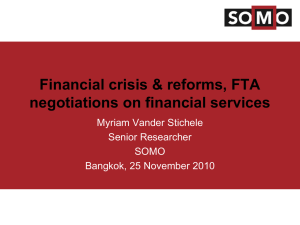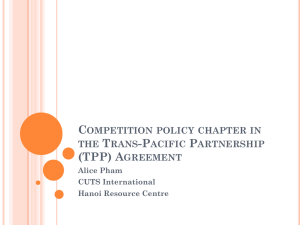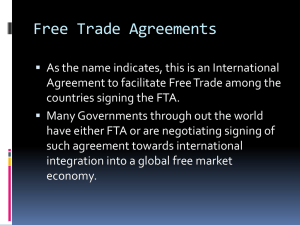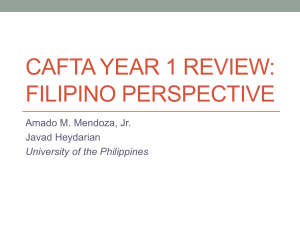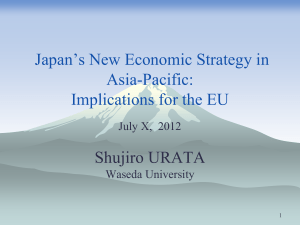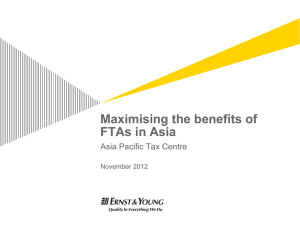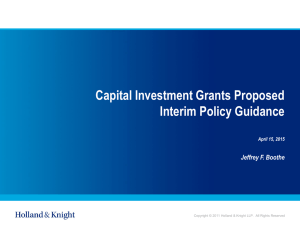The current international business environment has changed very
advertisement
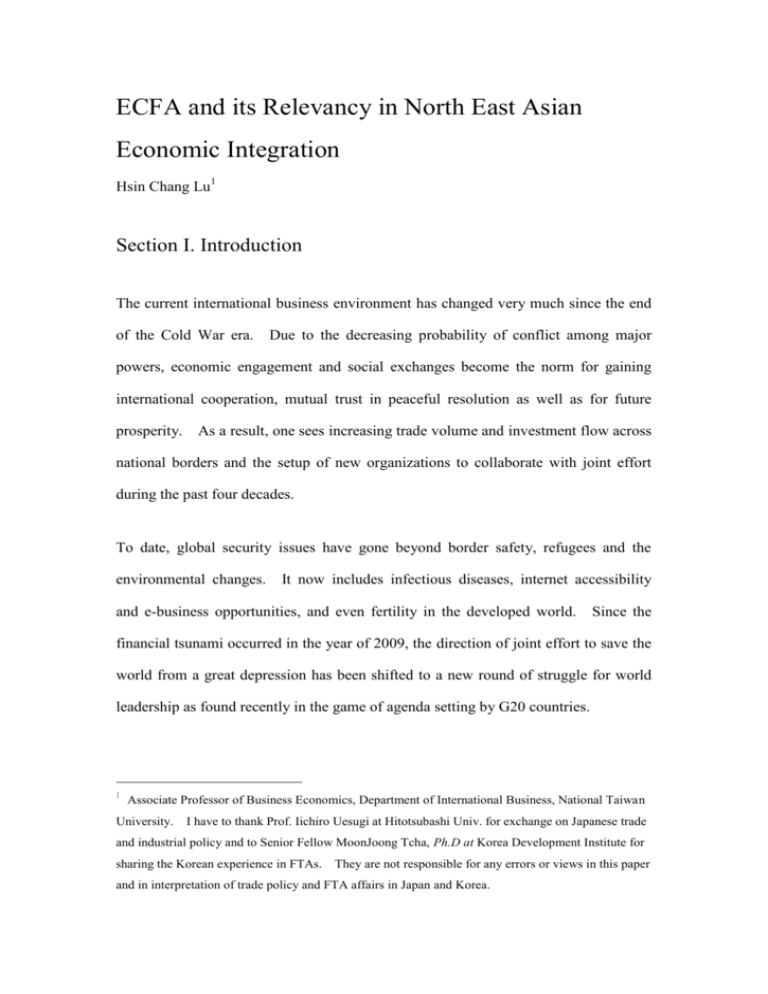
ECFA and its Relevancy in North East Asian Economic Integration Hsin Chang Lu1 Section I. Introduction The current international business environment has changed very much since the end of the Cold War era. Due to the decreasing probability of conflict among major powers, economic engagement and social exchanges become the norm for gaining international cooperation, mutual trust in peaceful resolution as well as for future prosperity. As a result, one sees increasing trade volume and investment flow across national borders and the setup of new organizations to collaborate with joint effort during the past four decades. To date, global security issues have gone beyond border safety, refugees and the environmental changes. It now includes infectious diseases, internet accessibility and e-business opportunities, and even fertility in the developed world. Since the financial tsunami occurred in the year of 2009, the direction of joint effort to save the world from a great depression has been shifted to a new round of struggle for world leadership as found recently in the game of agenda setting by G20 countries. 1 Associate Professor of Business Economics, Department of International Business, National Taiwan University. I have to thank Prof. Iichiro Uesugi at Hitotsubashi Univ. for exchange on Japanese trade and industrial policy and to Senior Fellow MoonJoong Tcha, Ph.D at Korea Development Institute for sharing the Korean experience in FTAs. They are not responsible for any errors or views in this paper and in interpretation of trade policy and FTA affairs in Japan and Korea. Regional conflicts of all sorts and potential threats from terrorism seem to be on the rise. What occurred between North and South Korea’s during the past year and the lasting conflict in currency value between China and the USA have intensified to run into a blame game. Considering of traditional threats as well as non-traditional threats, Japan, Korea and China have each proposed a multi-faceted security policy to address her own interest and exercise influence in separate fields of interest. For instance, it is considered necessary for Japan to reinforce the Japan-U.S. Security Arrangements to ensure prosperity and development2. Japan also actively advances diplomatic efforts towards fostering peace and stability in the international community, which is considered essential for promoting Japan's national interests. Korea also follows similar line of thinking and goes even further to invite EC to play a role in resolving nuclear proliferation and risk of a nuclear war on the Peninsular. On the way to foster diplomatic relationship for peace making, we also observe the conclusion of Korea-EC free trade agreement reached in 2010. In fact, East Asia has become the center of the world in terms of trade and investment arrangements. For policymakers on this side of the Pacific Ocean, the debate is no longer between effectiveness of regionalism against to the guiding principle of multilateralism. Dozens of free-trade agreements (FTAs) are signed since 1989 and turned East Asian into the "spaghetti bowl" type with intertwined free trade areas (Baldwin 2007). 2 The Ministry of Foreign Affairs (MOFA) of Japan released the Diplomatic Bluebook 2011 on April 1. In presenting the annual report, Minister Takeaki Matsumoto noted Japan is now facing its greatest national crisis since the Second World War. Japan has endeavored to deepen its alliance with the United States as the cornerstone to promote relations with neighboring countries. Regionalism has been widely accepted ever since and become the building blocks to paralleling a multilateral trading system. Whether FTAs promote trade depends on contribution to momentum towards global trade liberalization (Krueger, 1999). Therefore it is interesting in accounting for the rapidly evolving landscape of economic cooperation and assessing its importance into the near future, especially in ways to implement and consolidate between existing FTAs within East Asia. The question to assess the effect of spaghetti bowl is addressed in Frankel and Wei (1997). Were global free trade realized, the significance of FTAs will wither away. Arguments for or against have been advanced in both directions. Frankel, Stein and Wei (1995) summarize as to how the development of regional free trade arrangements might undermine movement toward multilateral liberalization as follows: Firstly, the negotiation process provides opportunities for manipulation by special interests; Secondly, the negotiation process draws on scarce negotiator resources and political energy, which may delay the multilateral process of the support it requires. On the other hand, it may as well help the movement toward further liberalization out of development of regional free trade areas. As also summarized in Frankel and Wei, favorable arguments include the following points: Firstly, FTAs tend to “built-in” unilateral liberalization that member governments cannot achieve otherwise, say by creating export-oriented constituencies; Secondly, the formation of FTAs can increase the efficiency and imagination of multilateral negotiations. It has been suggested that the main arena for trade liberalization in the next instance may well be through the FTA process – via the broadening of NAFTA into a Free Trade Area of the Americas (FTAA), the further broadening of the EU enlargement, continued deepening in the Asia-Pacific through APEC, and through linkages between these regional groupings something like Asia-Europe Meeting (ASEM). The difference in opinions can be best illustrated by the following remarks. The US Office of Trade Representatives insists that all WTO Members should engage in across-the-board negotiations to finalize the Doha Development Agenda 3 . Representative Michael Punke was quoted as saying that “….The gaps we must address result from problems of substance, not process, so as Members weigh ideas, the focus needs to be on how we deal with these substantive issues – not the shape of the negotiating table….” To the contrary, senior officials from the 21 member economies of the Asia-Pacific Economic Cooperation (APEC) Forum concluded in Washington meeting this March with the aim to build a “seamless regional economy.” Their focus will be on finding ways to strengthen regional economic integration, promote green growth, and advance regulatory cooperation. The organization of this paper is as the following: we start to examine the history of North East Asian Summits through examining documentation, news releases, various declarations of action plans, agreement and proposals made over the years in Section II. After examining the trend of FTAs during the past 50 years, we try to derive some causal reasoning behind successful completion of FTA deals. We contrast this effort by the three country sub-regional formation with wider ring organizations such as APEC, Tran Pacific Partnership (TPP) and Asia Pacific Trade Agreement (APTA) in Section III. In Section IV, we would like to see the relevancy of ECFA for the development of economic integration in North East Asia during this transition period. Conclusion is followed in Section V. 3 See the statement in Trade Negotiations Committee by U.S. Ambassador to the World Trade Organization , Deputy U.S. Trade Representative Michael Punke at Geneva, Switzerland on March 29, 2011. Section II Efforts for Free Trade Area in Northeast Asia Based on the perspective of global activism, the Japanese government engaged in various topics such as peace building, disarmament and non-proliferation of international terrorism and international organized crime (Japan Blue Book 2011). In return, Japan was elected as a non-permanent member of the United Nations Security Council in October of 2008 and participated in United Nations peacekeeping operations, including dispatching officers of the Japan Self-Defense Forces to the United Nations Mission in Sudan and assisting transportation activities in Iraq. Apparently, the making of FTA comes with the pursuit of many purposes other than consideration of economic growth and material well-beings. The influence exercised in the regional economy as well as significant role in WTO is also taken implicitly as important factors by some provokers. The deepening of economic interdependence may give rise to a sense of political trust among countries, which will expand Japan's global diplomatic influence and interests. Japan will continue in reforming Security Council and pursuing Japan's permanent membership in the Council. As many studies argue forcefully that FTAs may serve as an important supplement to the establishment of a multilateral trading system. Over the past decade, Korea comes out successfully in signing EU and the USA as economic partnership while Japan seems less aggressive and tends to meet with higher resistance from her trading partners. The Chinese Government also deems Free Trade Agreements as an effective approach to integrate and strengthen cooperation with other economies. Contrary to other developed countries with an aim to integrate with LDC’s and to harmonize existing trade-related regulations and industrial standards, Japan takes FTAs as one way to avoid turning economic frictions into political conflicts. Other than observing increasing trade as well as investment in Northeast Asia, we also notice the urging call for a possible FTA among China, Japan and Korea4. Below we will update the progress made so far among these three countries and make comparison about the urgency behind each proposal. 2.1 China-ROK Free Trade Area In November 2004, Chinese President Hu Jintao and former ROK President Roh-Moo-Hyun declared to launch of an unofficial feasibility study on China-ROK Free Trade Area during the APEC Summit Meeting held in Chile. The Development Research Center of the State Council of China and the Korea Institute for International Economic Policy conducted a joint “Feasibility Study for the China-Korea FTA” from 2005 to 2006. This report drew a solid conclusion that the FTA would be mutually beneficial for both countries. China and ROK then decided to upgrade the unofficial study to a study jointly made by government, business and academia in November, 2006. joint study was held in Beijing in March 2007. The first meeting of this The second meeting of Joint Research was held in Seoul from July 3 to 4 2007. The third meeting of this research was held in China from October 23 to 25 2007. These meetings touched upon a number of key issues in respect of China-South Korea FTA, including 4 The relevant declaration and joint statements can be found on government web pages in China, Japan and Korea. comparisons on the competitiveness of certain industries, the impact of establishing FTA, the principle for country of origin, and measures of trade remedy. During recent visit to South Korea, Chinese Premier Wen Jiabao and President of South Korea Lee Myung-bak announced to wrap up China and ROK joint study in June 2010. This study covered issues such as trade in goods, trade in service and investment through five joint research meetings. Policy recommendations, including suggested principles for negotiating were also included in the report. They finally reached a consensus regarding certain chapters in the joint research report. The joint study along with five meetings to exchange ideas has broadened mutual understanding and set up a good foundation for promoting China-ROK FTA. MOU between Korea and China for Free Trade Area was then signed by bilateral representatives, economic and trade ministers from both parties in June 2010. Currently, the two sides are still working on a few remaining issues to be agreed on to go forward. Both parties agreed to create conditions for launching talks soon5. 2.2 China-Japan-Korea FTA Dated back in 2002, the leaders of China, Japan and Korea all agreed to carry out the non-governmental academic research on China-Japan-Korea FTA. From 2003 to 2009, the research institutes of the three nations made a comprehensive and in-depth analysis about the feasibility. The report comes at no surprise that FTA could expand regional market and advance economic amalgamation of the three nations. 5 Korean Prime Minister Kim Hwang-sik, currently in Beijing on an official visit, told reporters on April 14, 2011 that Wen Jiabao had requested to officially start negotiations on a Korea-China free trade agreement. But Kim said that an in-depth study on sensitive topics such as farm products should be done before the actual meetings. On the second meeting of leaders from China-Japan-ROK in October of 2009, a consensus was reached to initiate a joint research by Government, Enterprises, and Universities on China-Japan-Korea FTA. A joint statement was then announced at the Sixth China-Japan-ROK Trade Ministers’ Conference to conduct this joint research in the first half of 2010. No doubt that China-Japan-ROK FTA is perceived as beneficial for expanding regional trade, promoting mutual benefits and boosting the economic integration process of Northeast Asia and East Asia. The Preparatory Conference for the joint research was held in Seoul, Korea, on January 26th 2010. The three parties exchanged views on tariff, non-tariff measures, rules of origin, trade remedy and economic cooperation accordingly. Participants discussed relevant issues such as terms of reference, and field research, and decided to hold the first session of joint research conference in Seoul, Korea, in April 2010. The 2nd Session of China-Japan-ROK Joint Research on FTA was held from September 1 to 3, 2010 in Tokyo, Japan. The 3rd Session with a focus on issues of trade in services and investment was held in Weihai, Shandong Province of China from December 1 to 3, 2010. The process of joint research and schedule of several meetings along the past decade is summarized as in figure 1. 2.3 Korea and Japan FTA The negotiation on a bilateral economic partnership agreement (EPA) between Japan and Korea was launched in December 2003 for a total of six round meetings under a joint study. Yet the negotiation was stopped at the completion of the joint study from November 2004 to May 2008. Then it was resumed again in June 2008 and started another 4 rounds of working level negotiation. Finally both parties met again and got into 1st round Director-General-Level Consultation on the operation of possible Korea-Japan FTA. However, there seems to be no plan for another round of meeting or negotiation till now. In February 2011, the foreign ministers of both countries agreed to resume the negotiation in April this year6. At current, it’s a difficult time for Japan and will certainly slow down many things in this regard. 2.4 Summary From the above discussion, it seems more positive between Korea and China to complete the joint study at half of the length of time relative to other FTA proposals. In fact, trade growth between Korea and China is twice as fast to that between China and Japan. Recent report in Beijing also confirmed the intention for both sides to kick into formal negotiation. However, the response made by Korea is not warm as they are pending more on the past of Korea-US FTA in no time. The deal making between Japan and Korea is also not clear. Japan seems interested more in a multilateral setting with vital partnership outside of Asia. Besides, the tension between Japan and China, and Korea and Japan respectively is still hard to be overcome, be it related to the context of history books or territory disputes. Historical tensions out of war memory, competing implicitly to lead in East Asia, and clashes over island territory and oil reserves all restrict the range for strengthening cooperative relations. 6 See the report at http://english.kyodonews.jp/news/2011/02/72333.html The future actually looks a bit gloomy as Sino-Japanese relationship may turn into an illusion after the shock by recent earth quake in Japan. As Japan needs assistance from Washington more now than ever, Japan may choose to stay passively along the development of Sino-Japanese economic partnership relation. Thus it’s quite interesting to examine if the end of fiscal expansion since the financial tsunami in 2009 will induce ever conservative response and more protectionism, or keep the current heat toward more trade liberalization in Asia. Section III Other Arrangements for Free Trade in Asia New and creative ways to increase trade and jobs are not just expected but proposed explicitly in the context of FTAs to facilitate market accessibility, eliminate trade barriers and so to reduce transaction costs,. As such, regulatory cooperation becomes a top priority under most negotiation. For instance, mutual recognition agreements (MRA’s) can establish procedures for accepting test results from laboratories or testing facilities in other countries. This type of cooperative effort will address the unnecessary regulatory difference, often perceived as extra loading to businesses and consumers. By MRAs dealing, a manufacturer will be allowed to test once and will see the same test results to be accepted elsewhere. product just Although less discussed openly among the Asian economies, the commitment to conclude WTO Doha Development Agenda is still urged forcefully by the US. WTO members are encouraged by the US side to demonstrate renewed energy and to engage with each other more seriously in across-the-board negotiations. To make the Doha Development Agenda into action, a lasting debate has taken place over the impact of FTAs on East Asian business during the past two decades. Some see the development of FTAs as harmful and label this trend as Asian "spaghetti bowl" where overlapping regional trade agreements will ultimately lead to too high administrative cost and too much bureaucracy, while others don’t see it that way. Some scholars emphasize on the net beneficial effects resulted from deeper regional integration and address the possibility of a building block to the end of multilateral liberalization globally. This contradictory view is partially solved after Asian financial crisis in 1997. Since then, assurance in trade opportunity and support for sustaining development need cooperation and mutual trust in any type. Japan began to sign its first FTA with Singapore in 2002 and Korea even set up a worldwide roadmap for FTA deals in 2003. Whether the multiple overlapping FTAs in East Asia is harmful to business activity or not, particularly for that of small- and medium-sized enterprises (SMEs), has been examined and criticized by Baldwin (1997). According to a survey collected by Asian Development Bank (ADB), the exemption of tariff within Asia through FTAs is used less likely. It suggests that the effect of Asian spaghetti bowl does not seem heavy and harmful to finally deter business activity. Nonetheless, as more FTAs take effect in the near future, the impact to business transaction is likely to be intensified in many ways. 3.1 APEC The core agenda of APEC is to strengthen regional economic integration by removing barriers to trade and investment. Currently, the 21 member economies jointly account for more than half of the global production and 44 percent of world trade. The APEC Senior Officials Meeting, chaired by U.S. Deputy National Security Advisor Michael Froman in March 2011, just concluded in Washington with an aim to build a seamless regional economy in the Asia-Pacific. This meeting will definitely lead to discussion of practical and concrete ways to strengthen regional economic integration, to promote growth under green technology , and to advance regulatory cooperation and convergence. They also agreed to identify the most onerous barriers faced by small- and medium-sized businesses and to address next generation trade and investment issues, such as to improve the performance of supply chain network and trade in technology. To promote green economic growth, APEC members discussed how to address non-tariff measures that affect trade in environmental goods, to streamline import procedures for advanced technologies, and to facilitate trade in products with recycled parts and materials. To advance regulatory cooperation and convergence, the APEC senior officials supported U.S. proposals to strengthen the implementation of good regulatory practices and improve the effectiveness of regulatory cooperation activities. APEC economies also agreed to address issues that have the potential to act as barriers to trade in emerging green technologies, including smart grid technology. All mentioned issues will be examined during the next APEC Senior Officials meetings, which will then lead up to the APEC Trade Ministers Meeting in May 2011, hosted by U.S. Trade Representative Ron Kirk. 3.2 TPP There have been six meetings held so far between United States and its TPP (Trans Pacific Partnership) partners, including Australia, Brunei Darussalam, Chile, Malaysia, New Zealand, Peru, Singapore and Vietnam. The latest round of meeting in Singapore this year made considerable progress and gave a strong boost to develop a high-standard trade agreement that will also support the creation of jobs than simply to promote economic growth. During this round, the United States and TPP countries made substantial headway toward a key goal of developing the legal texts of the TPP agreement, which includes commitments covering all aspects of trade and investment relationship. Recognizing the challenge of negotiating a regional agreement with nine countries, each country has displayed flexibility that is highly demanded to seal the negotiation. As a result, the teams were able to narrow the gaps in their positions over a wide range of issues displaced across the more than 25 chapters of the final agreement. The United States also tabled legal text on regulatory coherence - a new issue to feature in a trade agreement aimed at making the regulatory systems of the TPP countries operate more seamlessly. The U.S. also addressed issues such as “behind the border” that are key barriers for U.S. businesses trying to access foreign markets. The participating teams get to review the texts and have the chance to consult on the proposals in more detail with their respective governments. The proposals are meant to facilitate business, promote the participation of small- and medium-sized businesses in international trade and deepen the production and supply chain linkages. 3.3 APTA The Asia-Pacific Trade Agreement (APTA) is a preferential trade arrangement among developing countries. Up to now signatories to the Agreement include China, Bangladesh, India, Lao, Republic of Korea and Sri Lanka. APTA was formerly known as the Bangkok Agreement, an initiative of the United Nations Economic and Social Commission for Asia and the Pacific (UNESCAP) in 1975. The First Session of the Ministerial Council of the Bangkok Agreement was held in Beijing on November 2, 2005. Representatives from the member countries endorsed the revised text of the agreement and decided to rename the agreement as the Asia-Pacific Trade Agreement. To date, the outcome of the third round of tariff cut talks was successfully implemented by all members of APTA. A framework agreement was also signed during the third round of negotiations. Since the implementation of the third round of tariff concession in September of 2006, the number of certificate of origins under the Agreement issued by China increased to 146,000 in 2008 from 2,406 in 2004, an increase by 60% within 5 years. Also, the value of certificates in total amounted to 6,280 million USD in 2008 from 58.76 million USD in 2004, an increase by 106%. China’s imports under preferential treatment increased to 6.89 billion USD in 2008 from 1.28 billion USD in 2004, up by 438% in five years while the reduced tariff value amounted to 520 million USD in 2008 from 81.5 million USD in 2004, up by 539%. This is a much envied success in Asia indeed. 3.4 Summary The TPP, which is currently negotiated by nine countries including major agricultural exporters Australia and the United States, is aimed at requiring members to reduce all tariffs to zero within 10 years. Early this year in Washington, the United States representative has informed Japan on Tokyo’s possibility of participation in negotiation for the agreement. The US indicated that its broad goals for a TPP accord will exceed those pursued in other free trade pacts. Any country wishing to join the TPP negotiations also needs to secure the consent of all nine countries through bilateral talks. It (TPP?) signaled to Tokyo that it must make bolder steps to secure admission in TPP by eliminating most tariffs and offering greater market access in areas such as rice, beef and automobiles. Japan decided in November 2010 to start consultations with all nine countries to see if there is a likelihood for allowing joining the TPP negotiations. Prime Minister Naoto Kan said earlier this year that Tokyo’s stance on joining the TPP must be decided by June 2011#. Section IV. ECFA and its Relevance in Northeast Asia Most FTAs that are built on the foundation of the WTO Agreement may be seen as helpful way to protect private investment, to develop market-oriented policies and to promote trade. FTAs are of various forms. Most FTAs deal with bilateral relationship but some with multilateral agreements among several parties. FTAs may come with all kinds of terms and under different labeling due to special consideration and emphasis of needs by the related parties. For instance, the agreement signed between the United States and Panama on June 28, 2007 is called “trade promotion agreement” (TPA). To date, it still sits passively waiting for the approval by US Congress even though Panama already approved the TPA on July 11, 2007. Another type of trade agreement adopted quite commonly is called Trade and Investment Framework Agreement (TIFAs). TIFAs are more focused and allow for relevant parties to resolve trade and investment related issues at early stage. 4.1 Factors Contributed to the Deal Making of FTAs Trade agreements of all kinds can serve as means to work on capacity-building so as to induce investment and more market openness. FTAs should be negotiated based on the following principles as summarized from existing documents: i. Comprehensiveness: Elimination of tariffs and non-tariff barriers of all sorts in all areas, including plots and new regulation like “behind the border” rulings, a new kind of not-tariff barriers. ii. Consistency with WTO rules: Compliance with spirits of the WTO and with all the requirements stipulated in Article XXIV of the General Agreements on Tariffs and Trade (GATT) 1994 and Article V of the General Agreements on Trade in Services (GATS)#. iii. Consideration of sensitive sectors: Addressing the sensitivities of countries involved and offering in the form of package with concrete and proper solution. iv. Substantial liberalization: Significant liberalization beyond the level of liberalization commitment within the framework of the WTO. v. Sustainable development: Appropriate reflection of the international efforts to promote sustainable development, such as in the area of energy and climate control. Is there any pattern to follow for a high chance to strike a FTA deal? Take NAFTA as one example - it was signed at a time when the US economy was not as good after the first Gulf war of Kuwait in 1990. Besides, the sorrowful experience out of the Japanese dominance over manufacturing and inflow of foreign direct investment finally resulted in increasing trade deficit and shrinking employment. It was shocking for all the Americans for a while. The US became mentally prepared to grasp new opportunity and to meet competition from Mexican labor directly by then. Dated back to the presidential campaign in 1980, President Reagan proposed a "North American Accord." In the mid-1980s, President de la Madrid of Mexico opened the Mexican economy that led Mexico into the General Agreement on Tariffs and Trade (GATT) in 1987. Negotiations to deepen this trade and investment liberalization took place under the administration of President George Bush. Finally, this agreement was passed with the strong support of President Clinton at a critical time with the Republican dominance in Congress. When Mexico made the proposal to the US President Bush in the late 80’s, both countries suffered a heavy blow to the economy by “Peso Crisis”. The proposal for NAFTA was gladly accepted by three parties in North America and even expanded further south to include Chile at one time. Beyond anyone’s expectation, Mexico has since become actively in getting into FTA relationship as much as possible. Turkey behaved similarly after the completion of FTA with EC in 1995 (See Table 1). One simple measure of popularity of FTAs can be derived from Table 1. This can be calculated in number of FTAs in force relative to potential number of contracts to be proposed worldwide. We apply some selective criterion to come out with a narrow set of trade active countries: First, to include most active or influential countries in trade as clusters; Second, to include countries that are eager to look for FTA opportunity as revealed by their notification to WTO; Third, to exclude countries that do not have a chance to sign with more than two clustering countries (One can see the relevance of this criterion by counting dots along each row in Table 1). These three criteria help to narrow down a country list to a manageable set of 55 countries. This is done by using WTO list of RTAs in force and then ranking all countries by number of FTA deals concluded and put in force. Those who are taken as clusters come out with more than 8 notification of bilateral relationship while we use a cutoff point equal to 4 notifications each for countries taken as FTA active. In doing so, the final selective list actually excludes most countries from former Soviet Union and many countries in Middle East, Central Asia, Africa and South America. We treat EC, EFTA, Turkey, Chile, Japan, Mexico, Singapore, India, US and China as countries with at least eight FTAs and include Australia, Israel, New Zealand, Panama, ASEAN, Canada, Jordan, Korea, Costa Rica, Macedonia, Morocco, Peru, Russian Federation and Thailand in the list of those who have signed at least four FTAs. As there are 27 country members in EC, 4 countries in EFTA and 10 countries in ASEAN, the maximal bilateral contracts proposed would be 1,891 proposals out of this country list of 62. The FTAs already in force according to WTO record and applying to this restricted country list, amounts to 737. The ratio comes out at 38.9%. It means that countries covered by FTAs, one way or the other, amount to forty percent of them. The higher ratio means higher coverage of FTAs. Likewise, the higher coverage means higher bilateral trade relationship with other countries. The reason of low coverage rate by FTAs is quite simple. To put the above question from the opposite direction, if we can push integration between EC and ASEAN, for instance, then we can raise the coverage rate from 38.9% to 53% instead. So the next thing one can do to push for more trade integration is to focus on interrelationships of cluster. The coverage rate can be raised effectively by pushing for Supra FTAs on the top of existing FTAs. The remaining effort is to help countries which were excluded for some reasons from any multilateral FTAs to get into one. For instance, the US has a total of 17 countries with FTA relationship bilaterally or indirectly through multi FTA. Other than Guatemala and Honduras, most of these countries are already included in our selective county list. The US strikes with a low achievement grade, a mere 15 out of these 62 countries. In our FTA-active country list, the average coverage is of 38.9% while the US achievement amount to a coverage rate at 24%, way below indeed Businessmen and citizens in countries left behind must get anxious and feel put in disadvantage. They may even lose a great chance to enjoy market accession, cheap supply and some variety of goods. To succeed in promoting for more room of free trade and increasing competition, the above calculation comes out with a clear yet simple answer: to speed up integration among multilateral organizations and to help admission process for those countries left out for reasons we don’t know much. 4.2 Asian Experience with FTAs in the Past After more than 15 years of experiment and experience on market openness in East Asia and elsewhere in the world, several countries have invited more outside participants while sticking to the very guiding principle of free trade. ASEAN+1’s are among the recent examples. When time is right and confronted with less resistance, some courageous leaders will come forward to grasp the deal out of some realistic needs. This best proves that regionalism is not always an obstacle for a lead to multilateral free trade zone. The proliferation of FTAs in East Asia is a natural consequence of the region’s need to increase mutual trust and to expand trade in the absence of a Doha-round agreement. It also comes at a time when round-about production is extended very much and shipping of intermediate inputs becomes more frequent. Besides, a low-tariff policy under FTAs benefits foreign affiliates through shipping home of foreign production and so the domestic investors as foreign direct investment becomes common. However, the complicated knitting of FTAs brings both benefits and increasing cost in administration in the end. Thus, the implementation of policies and closer public-private sector cooperation will be needed to mitigate negative effects and facilitate business response to FTAs. Besides, all three countries in North East Asia are also eager to take lead in Asian affairs one way or the other (See Table 2). Japan is to rebuild national confidence through active international presentation both economically and politically. Korea focuses more on polishing an image of modern society and boosting its product sale by using FTAs for more market access. China has thorough consideration over increasing economic and political influence and is eager to get integrated into the global economy. In terms of headcount, the USA and China are comparable in a sense that each signed FTAs with several countries. Some FTAs are signed as a group deal with regional members such as Central America countries for the USA, and ASEAN for China respectively. Currently, China has eight Trade Agreements signed into force. Due to its sheer size and speed of development, the initial reactions among regional partners tend to be rather defensive as they perceive China as a strong export competitor and magnet for FDI inflow (See Table 3). Thus, China plays a double role in the Pacific Rim with great potential. First, it stiffens regional export competition in a broad spectrum of products. In this regard the Chinese economy has been taken as a threat. Second, the long-term growth trajectory makes China a prominent importer from the world. In fact, China intends to improve longer term visibility and identify opportunity for other East Asian economies. Unfortunately, this aspect of a potential market to come has so little attention. 4.3 Proposals to Smooth Asian Economic Integration Given the proliferation of FTAs in East Asia, one expects to see an increasing need for consolidation of overlapping ROOs (rules of origin) and make FTAs into a simpler but widening agreement. However, at the firm level, the results out of ADB survey do suggest that exporting firms are benefited from FTAs (Chia, 2010). China’s economic neighbors should place higher priority on policies that facilitate Chinese market access than on diverting the threat in export competition. By expanding FTA area and increasing tariff cut to a wider spectrum of Asian exporters, the cost and negative impact can be mitigated. While commitment to the WTO by China invites a reappraisal of regionalism - the real effects in existing arrangements would be far reaching and important to policy makers. After the decision to apply for WTO membership, foreign investment into China sky rocketed. Under WTO rulings, it comes naturally to question both the concept of nonalignment in the political sphere and the central economic tenets of regionalism. Adoption of the WTO agenda has given special impetus to globalization as the prevailing standard for multilateralism. For the reasons above, East Asia's existing trade arrangements will undergo significant change in the coming years. For instance, including China in ASEAN could induce dramatic trade diversion across the region and economies outside East Asia. Conversely, any East Asian economy that follows cost effectiveness for trade orientation could seriously compromise domestic and bilateral interests embedded in the existing regional arrangements. Thus, the resurgence of APEC and motives behind TPP are other responses to promote free trade under a multilateral system. The argument that regionalism constitutes a gradualist’s approach to globalization may not be defensible on its own. East Asian regionalism may or may not be "on the path" to globalization is an open question to be examined over time. It is because patterns of structural adjustment and burden of trade diversion may differ at various stages of development. In fact, the political economy supporting regionalism verse globalization may differ as well in nontrivial ways and vary from time to time. As such, it’s no wonder to see that Japan was reluctant to any regional dealing in the 80’s and early 90’s, and then became active in bilateral relationships between 1998 and 2005, and then begins to hesitate once again recently. 4.4 The Relevance of ECFA in North East Asia Integration On Jan. 1 2010, the China-ASEAN Free Trade Area became in effect which resulted in lower tariff on majority of exports and imports to near zero. This development brings challenges for Taiwanese firms as members of the Association of Southeast Asian Nations are major export markets for Taiwan. Taiwanese businesses grew concerned and worried that they were being left out. Previously, due to the lack of an economic agreement with the mainland and other major economies, Taiwan has been unable to join in the region's economic integration process. ECFA is welcomed in this sense although it is still at the early stage and looks for more solid arrangement by two-way dialogue. It is full of possibility and potential as the content of a FTA can be of anyone’s dream. It allows China to show its peaceful intention to the world. ECFA can also serve as a stepping stone for Taiwan to honor its obligation as well as its international citizenship. We address the following questions and try to assess if ECFA can be of any help. Question one: Can China and Korea lead in a new round of FTAs development in Asia? People wonder if there would be much interest and effort to promote free trade after the financial crisis in 2009. Recently we saw Korea and China take the lead to wrap up a joint study for feasibility of FTA and plan for immediate negotiation. The leaders of both countries’ are in high mood to pursue this goal with an all-out effort. On the other hand, there seems to be no intention to start a joint study for an FTA between China and Japan. The tripartite effort for East Asia Free Trade Agreement (EAFTA) is not clear in the near future as the joint study is still under way. As such, Korea and China may need to move along with their separate FTA. It seems even less likely to push through since Japan is fully occupied with rehabilitation of its tsunami-damaged northeast region. Question two: Can ECFA help speed up FTAs in Northeast Asia? The risk to concentrate production at one location has been shown detrimental after the earthquake in Japan. Besides, multiple sourcing as well as stretching the supply chain can lead to best use of resources and leveraging comparative advantage from various sources. ECFA might serve as a good substitute for either county in the Northeast Asia to circumvent trade barrier and diversify investment risk one way or the other. In the past, we have seen many breakthroughs in negotiating trade agreement. The pattern summarized from successful FTAs indicates that countries at disadvantage and at a hard time, tended to propose first to win support from the strong countries with upper hand. In countries where proposals for FTAs were accepted by strong countries, the next development is to see that neighboring countries choose to follow the example and jump in the bandwagon of FTA process. Cases similar to Mexico’s admission into NAFTA or Turkey’s inclusion with EC are abundant. Chile, with a total of 15 FTAs, also serves as a good example for countries to pursue FTAs (See Table 1). After signed with Canada and Mexico in the late 90’s respectively, Chile started a fast run to sign up with almost any country active in trade and regional events. These cases are full of surprise and result in a great achievement not just to boost local economies but modernize the business environment and stimulate ambition in low developed neighboring community. Even a large economy needs compelling reasons to persuade and win support from domestic interest groups. Right after China signed an accord with ASEAN in 2005, Japan agreed to sign into the same deal within three years. When the US proposed to sign TPP with South countries, Japan starts to show its interest to join gradually. Now we see a freer East Asian economy with increasing trade and investment. How far can ECFA lead to change? There is no set of fixed rules to follow but full of imagination. Question three: How to classify ECFA according to the WTO ruling? Notice that the cooperation deals between Hong Kong and Macau are treated and listed as FTAs by State Administration of Industry and Commerce, China. Are we going to see such official status recognized in the future for ECFA? If not, as expected, then can we push further to sign with other countries or trading partners? Even more interesting question is that: can ECFA start a new momentum for a next round of boom in trade liberalization in Northeast Asia? Can other countries agree to use some other forms of FTAs such as the formation of Trade and Investment Framework Agreement to integrate Northeast Asian economies? V. Concluding Remarks Other than debates over extent and benefits of globalization, FTAs in East Asia already confer economic gains and contribute to political stability. Thus, it’s safe to say that regional extension and cooperation will become wider apart and deeper. It’s necessary for people in the academics to increase their understanding of the structural details of trade liberalization, economic adjustment and growth. Despite the complexity of strategic reasoning and uncertainty of the trade-offs between prosperity and security issues, the path of regionalism in East Asia are already well-trodden. After the current crisis in Japan, we expect to see more the changing linkage and evolution of industrial supply chain, and finally the reallocation of value-added production across Asian countries. This study may help economies to realize the full potential of East Asian regional trade and facilitate in an eventual transition to more liberal trade globally. References Baldwin, Richard (2007) “Managing the Noodle Bowl: The Fragility of East Asian Regionalism”, ADB Working Paper Series on Regional Economic Integration, No. 7, Office of Regional Economic Integration, Asian Development Bank, Manila. Frankel, Jeffrey A., Ernesto Stein and Shang-Jin Wei (1997) Regional trading blocs in the world economic system. Frankel, Jeffrey A., and Shang-Jin Wei., (1997) “The New Regionalism and Asia: Impact and Options”, in M.G.Quibria and Arvind Panagariya, eds., The Emerging Global Trading Environment and Developing Asia, Asian Development Bank. Frankel, Jeffrey, Ernesto Stein, and Shang-Jin Wei (1995) "Trading Blocs and the Americas: The Natural, the Unnatural, and the Super-Natural." Journal of Development Economics, 47(1): 61-96. Hufbauer, Gary Clyde and Wong, Yee (2005) “Prospects for Regional Free Trade in Asia”, Institute for International Economics, Working Paper No. 05-12. Kawai, Masahiro and Wignarja, Ganeshan. (October 1, 2010) “Asian FTAs: Trends, Prospects, and Challenges”, Asian Development Bank Economics, Working Paper Series No. 226. Krueger, A.O. (1999), “Are preferential trading arrangements trade-liberalizing or protectionist?”, Journal of Economic Perspectives 13, 4, pp. 105–125. Sally, Razeen (2008) Trade Policy, New Century: The WTO, FTAs and Asia Rising,. Table 1. Worldwide FTAs Matrix by Most Active Countries EC (28) EFTA (18) Turkey (17) Chile (15) EC(28) ◎ ◎ ◎ EFTA(18) ◎ ◎ ◎ Turkey(17) ◎ ◎ Chile(15) ◎ ◎ Ukraine (12) Japan (11) Mexico (11) Singapor India e (9) (11) US (9) China (8) ◎ ◎ ◎ ◎ ◎ ◎ ◎ ◎ ◎ ◎ ◎ Ukraine(12) ◎ Japan(11) Mexico(11) ◎ Singapore(11 ) India(9) ◎ ◎ ◎ ◎ ◎ ◎ ◎ ◎ ◎ US(9) ◎ ◎ China(8) ◎ ◎ ◎ Armenia(7) ◎ Australia(7) ◎ Georgia(7) Israel(6) Kyrgyz Republic(6) New Zealand(6) Panama(6) ◎ ◎ ◎ ◎ ◎ ◎ ◎ ◎ ◎ ◎ ◎ Costa Rica(4) El Salvador(4) Faroe ◎ Islands(4) Former Yugoslav Republic of ◎ Macedonia(4) Kazakhstan(4 ) Morocco(4) ◎ ◎ ◎ ◎ ◎ ◎ ◎ Korea(5) ◎ ◎ ◎ Canada(5) ◎ ◎ ◎ ◎ ◎ ◎ ◎ ◎ ◎ ◎ ◎ ◎ ◎ ◎ ◎ ◎ Peru(4) Russian Federation(4) Thailand(4) Others ◎ ◎ ASEAN(5) Jordan(5) ◎ ◎ ◎ ◎ Albania Algeria Andorra B&H Cameroon Cariforum Côte Albania Croatia Egypt Lebanon Palestinia n Authority Albania Colombi Bosnia and a Herzegovin a Croatia Egypt Montenegro Azerbaijan Belarus Moldova Tajikistan Uzbekistan Turkmenista n ◎ Brunei Darussala m Indonesia Malaysia Philippines Switzerlan Colombia Guatemal a Honduras Nicaragua Afghanista Bahrain HK n Oman Macao Bhutan Pakistan Nepal Mercosur Sri Lanka d'Ivoire SACU Croatia Serbia Egypt Tunisia Iceland Lebanon Montenegro Norway OCT Palestinian Authority South Africa Switzerland Syria Tunisia Palestinian Authority Serbia Syria Tunisia d Vietnam Source of Data: http://rtais.wto.org/ui/PublicMaintainRTAHome.aspx WTO for Regio Table 2. Status of FTAs with China, Japan and Korea Free Trade Agreements Concluded FTA status of China Free Trade Agreements under Negotiation China-ASEAN FTA China-Chile FTA China-Costa Rica FTA China-New Zealand FTA China-Pakistan FTA China-Peru FTA China-Singapore FTA Mainland and Hong China-SACU(Southern African Customs Union) FTA China-Switzerland FTA Joint Study Kong Closer Economic and Partnership Arrangement Mainland and Macau Closer Economic and Partnership Arrangement FTA status of Japan ASEAN-Japan Comprehensive Economic Partnership Agreement Japan-Brunei Economic Partnership Agreement Japan-Chile Economic Partnership Agreement Japan-India Economic Partnership Agreement Japan-Indonesia Economic Partnership Agreement Japan-Malaysia Economic Partnership Agreement China-Australia FTA China-GCC(Gulf Cooperation Council) FTA China-Iceland FTA China-Norway FTA Japan-Australia Economic Partnership Agreement Japan-Peru Economic Partnership Agreement Free Trade Agreements under Consideration China-India Regional Trade Arrangement Joint Feasibility Study China-Japan-Korea Joint Study China-Korea FTA Joint Feasibility Study Japan-Republic of Korea Economic Partnership Agreement Japan-Mongolia Economic Partnership Agreement FTA status of Korea Japan-Mexico Economic Partnership Agreement Japan-Philippines Economic Partnership Agreement Japan-Singapore Economic Partnership Agreement Japan-Switzerland Economic Partnership Agreement Japan-Thailand Economic Partnership Agreement Japan-Viet Nam Economic Partnership Agreement Korea-ASEAN FTA Korea-Chile Korea-EFTA Korea-Australia FTA Korea-Canada FTA Korea-Colombia FTA Korea-EU FTA Korea-India Korea-Peru FTA Korea-Singapore Korea-U.S. FTA Korea-GCC FTA Korea-Mexico FTA Korea-New Zealand FTA Korea-Turkey FTA Source of Data: http://fta.mofcom.gov.cn/index.shtml http://www.mofa.go.jp/index.html http://www.mofat.go.kr/english/main/index.jsp Korea-Central America FTA Korea-China FTA Korea-China-Japan FTA Korea-Israel FTA Korea-Japan FTA Korea-MERCOSUR TA Korea-Russia BEPA Korea-SACU FTA Table 3. World FDI Stock by Development Status, 1990-2009 Inward Stock ($Billions) Host region/economy 1990 1995 2000 2005 2009 Total Inward Stock 2081.8 3381.3 7442.5 11524.9 17743.4 Developed Economies Developed Share as % of total US Inward Stock US Share of Developed Stock 1555.6 74.7% 539.6 34.7% 2521.5 74.6% 1005.7 39.9% 5653.2 76.0% 2783.2 49.2% 8535.8 74.1% 2818.0 33.0% 12352.5 69.6% 3120.6 25.3% Developing Economies Developing Share as % of total China Inward Stock Chinese Share of Developing Stock 524.5 25.2% 20.7 3.9% 848.4 25.1% 101.1 11.9% 1728.5 23.2% 193.3 11.2% 2713.6 23.5% 272.1 10.0% 4893.5 27.6% 473.1 9.7% 1990 1995 2000 2005 2009 Total Outward Stock 2086.8 3606.6 7967.5 12416.8 18982.1 Developed Economies Developed Share as % of total US Outward Stock 1941.1 93.0% 731.8 3272.2 90.7% 1363.8 7083.5 88.9% 2694.0 10956.4 88.2% 3638.0 16010.8 84.3% 4302.9 US Share of Developed Stock 37.7% 41.7% 38.0% 33.2% 26.9% Developing Economies 145.2 330.0 862.6 1308.4 Developing Share as % of total 7.0% 9.1% 10.8% 10.5% China Outward Stock 4.5 17.8 27.8 57.2 Chinese Share of Developing Stock 3.1% 5.4% 3.2% 4.4% Data Source: UNCTD Statistics__Foreign Direct Investment http://unctadstat.unctad.org/ReportFolders/reportFolders.aspx 2691.5 14.2% 229.6 8.5% Outward Stock ($Billions) Host region/economy 1999 2000 2001 2002 2003 2004 2005 2006 2007 2008 2009 2010
